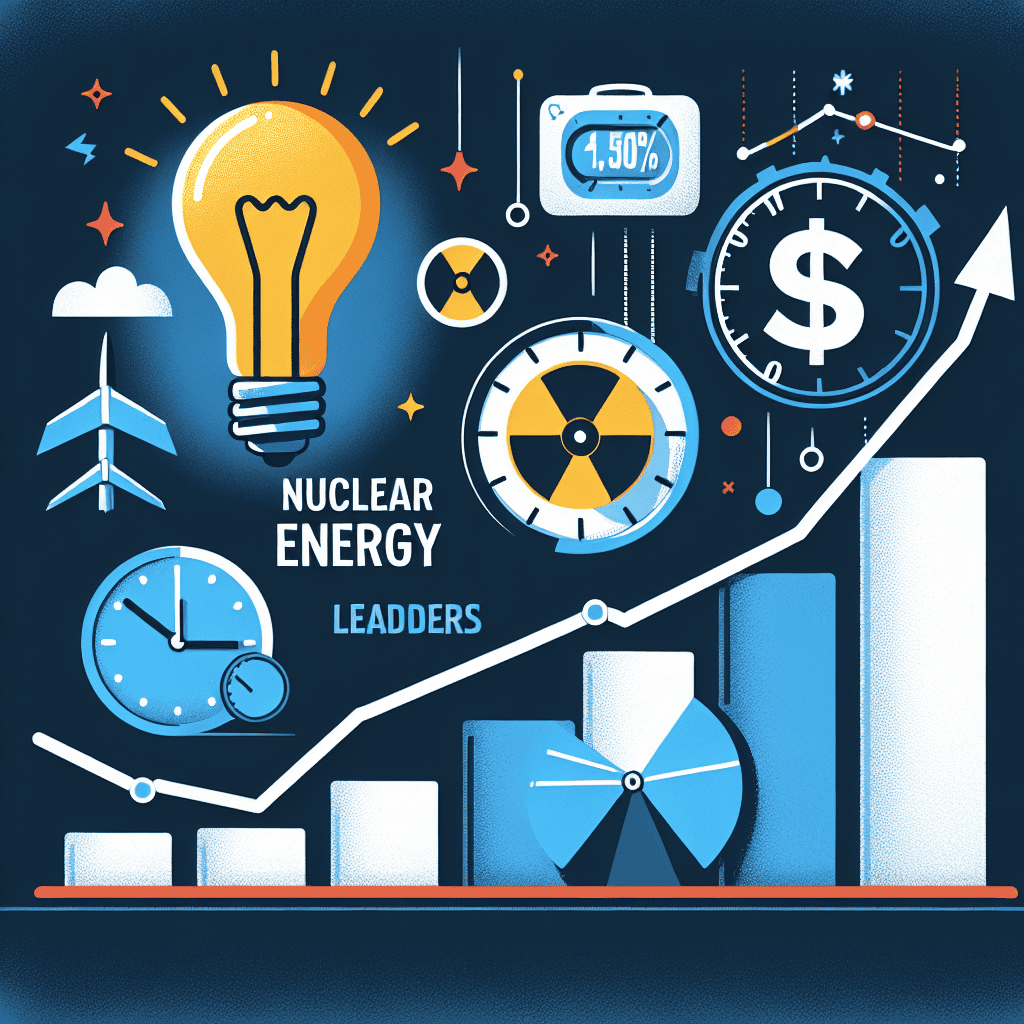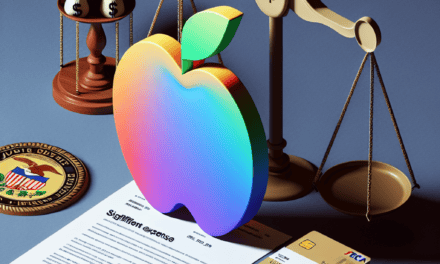“Power Surge: S&P 500 Nuclear Leaders Soar 30% After Microsoft Deal, Eye Earnings Season”
Introduction
The S&P 500 Nuclear Energy Leaders index has experienced a significant surge, climbing 30% following a landmark deal with tech giant Microsoft. This remarkable growth underscores the increasing investor confidence in the nuclear energy sector, driven by strategic partnerships and technological advancements. The collaboration with Microsoft highlights the potential for nuclear energy to play a pivotal role in sustainable energy solutions, aligning with global efforts to reduce carbon emissions. As the earnings season approaches, market analysts and investors are keenly observing how these developments will influence the financial performance of companies within the index, potentially setting the stage for further growth and innovation in the nuclear energy landscape.
Impact Of Microsoft Deal On S&P 500 Nuclear Energy Leaders
The recent surge in the S&P 500 Nuclear Energy Leaders, marked by a remarkable 30% increase, has captured the attention of investors and analysts alike. This significant uptick follows the announcement of a strategic partnership with Microsoft, a move that has injected renewed optimism into the nuclear energy sector. As the earnings season approaches, stakeholders are keenly observing how this development will influence the financial performance and strategic direction of the companies involved.
The collaboration with Microsoft is a testament to the growing recognition of nuclear energy as a pivotal component in the transition to sustainable energy solutions. By leveraging Microsoft’s technological prowess and vast resources, nuclear energy companies are poised to enhance their operational efficiencies and accelerate innovation. This partnership underscores a broader trend where technology giants are increasingly aligning with energy firms to address the pressing challenges of climate change and energy security.
Moreover, the deal is expected to facilitate the integration of advanced digital technologies into nuclear operations. This includes the use of artificial intelligence and machine learning to optimize reactor performance, improve safety protocols, and reduce operational costs. Such advancements are crucial as the nuclear sector seeks to bolster its competitiveness against other renewable energy sources. The anticipated improvements in efficiency and safety are likely to bolster investor confidence, further driving the sector’s growth.
As the earnings season looms, market participants are eager to assess the tangible impacts of the Microsoft deal on the financial health of the S&P 500 Nuclear Energy Leaders. Analysts predict that the partnership could lead to an uptick in revenue streams, driven by enhanced operational capabilities and potential new business opportunities. Additionally, the collaboration may result in cost savings, which could positively impact profit margins. Investors will be scrutinizing earnings reports for indications of these benefits, as well as any forward-looking statements that provide insight into future growth prospects.
Furthermore, the strategic alliance with Microsoft may serve as a catalyst for further partnerships between nuclear energy companies and other technology firms. Such collaborations could unlock additional avenues for innovation and growth, positioning the nuclear sector as a key player in the global energy landscape. The potential for cross-industry synergies is vast, and the success of this initial partnership could pave the way for similar initiatives in the future.
In conclusion, the 30% surge in the S&P 500 Nuclear Energy Leaders following the Microsoft deal highlights the transformative potential of strategic partnerships in the energy sector. As the earnings season approaches, all eyes will be on the financial performance of these companies, with investors eager to see how the collaboration translates into tangible results. The integration of cutting-edge technologies promises to enhance the sector’s competitiveness and sustainability, offering a glimpse into the future of nuclear energy. As the world continues to grapple with the dual challenges of climate change and energy demand, the role of nuclear energy, bolstered by strategic alliances, is likely to become increasingly prominent.
Analyzing The 30% Surge In Nuclear Energy Stocks
The recent surge in nuclear energy stocks within the S&P 500, marked by a remarkable 30% increase, has captured the attention of investors and analysts alike. This surge follows a significant deal with Microsoft, which has further underscored the growing importance of nuclear energy in the global transition towards sustainable energy solutions. As the earnings season approaches, stakeholders are keenly observing how these developments will influence the financial performance of companies within this sector.
The collaboration with Microsoft has been a pivotal factor in the recent uptick in nuclear energy stocks. By partnering with a tech giant known for its commitment to sustainability, nuclear energy companies have gained a substantial vote of confidence. This partnership not only highlights the potential of nuclear energy as a reliable and clean power source but also aligns with the broader trend of technology companies seeking to reduce their carbon footprints. Consequently, this has led to increased investor interest and optimism about the future prospects of nuclear energy.
Moreover, the global energy landscape is undergoing a significant transformation, with an increasing emphasis on reducing carbon emissions and combating climate change. Nuclear energy, with its low carbon emissions and high energy output, is being recognized as a crucial component of the energy mix needed to achieve these goals. This recognition has been further bolstered by recent policy shifts and government incentives aimed at promoting clean energy technologies. As a result, nuclear energy companies are well-positioned to benefit from these favorable conditions, which is reflected in their stock performance.
In addition to the Microsoft deal, the upcoming earnings season is another factor contributing to the heightened interest in nuclear energy stocks. Investors are eagerly anticipating the financial results of these companies, as they will provide valuable insights into the sector’s current performance and future potential. Positive earnings reports could further validate the recent surge in stock prices, while any unexpected challenges could prompt a reassessment of the sector’s outlook. Therefore, the earnings season represents a critical juncture for nuclear energy companies, as it will shape investor sentiment and influence future investment decisions.
Furthermore, the technological advancements within the nuclear energy sector are also playing a significant role in driving stock performance. Innovations in reactor design, waste management, and safety protocols are enhancing the efficiency and appeal of nuclear energy. These advancements are not only making nuclear power more competitive with other renewable energy sources but are also addressing longstanding concerns about safety and environmental impact. As these technologies continue to evolve, they are likely to attract further investment and support from both the public and private sectors.
In conclusion, the 30% surge in nuclear energy stocks within the S&P 500 is a multifaceted phenomenon driven by strategic partnerships, favorable policy environments, and technological advancements. The Microsoft deal has served as a catalyst for renewed interest in the sector, while the upcoming earnings season will provide crucial insights into its financial health and future trajectory. As the world continues to prioritize sustainable energy solutions, nuclear energy is poised to play an increasingly vital role, offering investors a promising opportunity to participate in the global energy transition.
Earnings Season: What To Expect From Nuclear Energy Companies
The recent surge in the S&P 500’s nuclear energy leaders, marked by a remarkable 30% increase following a strategic deal with Microsoft, has captured the attention of investors and analysts alike. As the earnings season approaches, stakeholders are keenly observing the potential implications of this development on the financial performance of nuclear energy companies. This surge is not merely a reflection of market optimism but also indicative of the growing recognition of nuclear energy as a pivotal component in the global transition towards sustainable energy solutions.
The collaboration with Microsoft underscores a significant shift in the energy landscape, where technology giants are increasingly aligning with energy providers to secure reliable and sustainable power sources. This partnership is expected to enhance the operational capabilities of nuclear energy firms, providing them with the technological edge needed to optimize their energy output and efficiency. Consequently, as earnings reports are anticipated, there is a heightened expectation that these companies will demonstrate improved financial metrics, driven by increased demand and operational efficiencies.
Moreover, the nuclear energy sector is poised to benefit from favorable regulatory environments and government incentives aimed at reducing carbon emissions. With global climate goals becoming more stringent, nuclear energy is being positioned as a viable alternative to fossil fuels, offering a low-carbon solution that can meet the growing energy demands. This regulatory support is likely to translate into positive financial outcomes for nuclear energy companies, as they capitalize on subsidies and tax incentives designed to promote clean energy initiatives.
In addition to regulatory advantages, the technological advancements facilitated by the Microsoft deal are expected to play a crucial role in enhancing the competitiveness of nuclear energy firms. By integrating cutting-edge technologies such as artificial intelligence and data analytics, these companies can optimize their operations, reduce costs, and improve safety measures. This technological integration is anticipated to be a key driver of profitability, as it enables nuclear energy providers to operate more efficiently and effectively in a competitive market.
Furthermore, the strategic partnership with Microsoft is likely to open new avenues for revenue generation, particularly in the realm of digital services and solutions. As nuclear energy companies leverage Microsoft’s expertise in cloud computing and data management, they can offer innovative services that cater to the evolving needs of their clients. This diversification of revenue streams is expected to bolster the financial resilience of these firms, making them more attractive to investors seeking stable and sustainable returns.
As the earnings season unfolds, investors will be closely monitoring the financial disclosures of nuclear energy companies to assess the impact of these developments on their bottom lines. Key performance indicators such as revenue growth, profit margins, and capital expenditures will be scrutinized to gauge the effectiveness of the Microsoft partnership and the broader market dynamics. Analysts will also be paying attention to forward-looking statements and guidance provided by company executives, as these insights will offer valuable clues about the future trajectory of the nuclear energy sector.
In conclusion, the 30% surge in S&P 500 nuclear energy leaders following the Microsoft deal is a testament to the sector’s growing prominence in the energy market. As earnings season approaches, the focus will be on how these companies leverage technological advancements, regulatory support, and strategic partnerships to drive financial performance. The outcomes of this earnings season will not only reflect the current state of the nuclear energy industry but also shape investor sentiment and strategic decisions in the months to come.
Microsoft’s Influence On The Nuclear Energy Sector

The recent surge in the S&P 500 nuclear energy leaders, marked by a remarkable 30% increase, can be largely attributed to a groundbreaking deal with Microsoft. This development has not only captured the attention of investors but also highlighted the growing influence of technology giants in the energy sector. As the earnings season approaches, stakeholders are keenly observing how this partnership will shape the future of nuclear energy and its role in the broader energy landscape.
Microsoft’s involvement in the nuclear energy sector is a testament to the increasing convergence of technology and energy industries. By investing in nuclear energy, Microsoft aims to diversify its energy portfolio and enhance its sustainability initiatives. This move aligns with the company’s commitment to achieving carbon neutrality and underscores the potential of nuclear energy as a viable solution for reducing carbon emissions. The partnership has provided a significant boost to nuclear energy companies, as evidenced by the substantial rise in their stock prices within the S&P 500 index.
The collaboration between Microsoft and nuclear energy leaders is expected to drive innovation and efficiency in the sector. By leveraging Microsoft’s technological expertise, nuclear energy companies can enhance their operational capabilities, improve safety measures, and optimize energy production. This synergy is likely to result in more cost-effective and sustainable energy solutions, which could further bolster the appeal of nuclear energy as a key component of the global energy mix.
Moreover, the timing of this partnership is particularly noteworthy as it coincides with the growing demand for clean energy solutions. Governments and corporations worldwide are increasingly prioritizing sustainability, and nuclear energy is gaining recognition as a reliable and low-carbon energy source. The Microsoft deal serves as a catalyst for the nuclear energy sector, potentially accelerating its growth and adoption in the coming years.
As the earnings season approaches, investors are eagerly anticipating the financial performance of nuclear energy companies within the S&P 500. The recent surge in stock prices has set high expectations, and market analysts are keen to assess the impact of the Microsoft partnership on these companies’ earnings. While the deal has undoubtedly provided a short-term boost, the long-term implications for revenue growth and profitability remain to be seen. Investors will be closely monitoring key performance indicators, such as revenue growth, profit margins, and capital expenditures, to gauge the sustainability of this upward trend.
In addition to financial metrics, stakeholders will also be interested in understanding how nuclear energy companies are integrating Microsoft’s technology into their operations. The ability to effectively harness technological advancements will be crucial in maintaining a competitive edge and driving future growth. As such, companies that demonstrate a strong commitment to innovation and adaptability are likely to be favored by investors.
In conclusion, the Microsoft deal has significantly influenced the nuclear energy sector, propelling S&P 500 nuclear energy leaders to new heights. This partnership underscores the potential of nuclear energy as a sustainable solution and highlights the growing role of technology in shaping the future of the energy industry. As the earnings season unfolds, investors and industry observers will be closely watching to see how this collaboration impacts the financial performance and strategic direction of nuclear energy companies. The outcome will not only provide insights into the sector’s growth prospects but also offer a glimpse into the evolving dynamics of the global energy landscape.
S&P 500 Nuclear Energy Leaders: A New Era Of Growth
The recent surge in the S&P 500 Nuclear Energy Leaders, marked by a remarkable 30% increase, has captured the attention of investors and industry analysts alike. This impressive growth follows the announcement of a strategic partnership with Microsoft, a move that has injected renewed optimism into the nuclear energy sector. As the earnings season approaches, stakeholders are keenly observing how this development will influence the financial performance and strategic direction of these companies.
The collaboration with Microsoft is a significant milestone for the nuclear energy leaders within the S&P 500, as it underscores the growing recognition of nuclear power as a viable and sustainable energy source. This partnership is expected to leverage Microsoft’s technological expertise to enhance the efficiency and safety of nuclear energy operations. By integrating advanced data analytics and artificial intelligence, the collaboration aims to optimize nuclear plant performance, reduce operational costs, and improve safety protocols. Consequently, this could lead to increased investor confidence and a broader acceptance of nuclear energy as a critical component of the global energy mix.
Moreover, the timing of this partnership is particularly noteworthy as it coincides with a global shift towards cleaner energy sources. With increasing pressure to reduce carbon emissions and combat climate change, nuclear energy is being reconsidered as a key player in achieving these environmental goals. Unlike fossil fuels, nuclear power generates electricity with minimal greenhouse gas emissions, making it an attractive option for countries striving to meet their climate commitments. The endorsement from a tech giant like Microsoft further validates the potential of nuclear energy to contribute to a sustainable future.
As the earnings season approaches, investors are eager to assess the financial implications of this partnership on the nuclear energy leaders within the S&P 500. Analysts anticipate that the collaboration could lead to increased revenue streams and improved profit margins, driven by enhanced operational efficiencies and potential new business opportunities. Additionally, the partnership may pave the way for further collaborations with other technology companies, opening up new avenues for growth and innovation in the nuclear energy sector.
However, it is important to acknowledge the challenges that lie ahead. The nuclear energy industry has historically faced significant hurdles, including high capital costs, regulatory complexities, and public perception issues. While the partnership with Microsoft is a positive step forward, it does not eliminate these challenges entirely. Companies will need to navigate these obstacles carefully to fully capitalize on the opportunities presented by this collaboration.
In conclusion, the 30% surge in the S&P 500 Nuclear Energy Leaders following the Microsoft deal marks a new era of growth and optimism for the sector. As the earnings season approaches, all eyes will be on how these companies leverage this partnership to enhance their financial performance and strategic positioning. The collaboration not only highlights the potential of nuclear energy as a sustainable power source but also signals a broader industry trend towards integrating technology to drive innovation and efficiency. While challenges remain, the path forward appears promising, with the potential for nuclear energy to play a pivotal role in the global transition to cleaner energy solutions.
Strategic Partnerships: Microsoft And Nuclear Energy Firms
In recent weeks, the S&P 500 has witnessed a remarkable surge in the stocks of nuclear energy leaders, with a notable 30% increase following a strategic partnership with Microsoft. This development underscores the growing importance of nuclear energy in the global transition towards sustainable energy solutions. As the world grapples with the challenges of climate change and the need for reliable, low-carbon energy sources, nuclear energy is increasingly being recognized as a vital component of the energy mix. The collaboration between Microsoft and leading nuclear energy firms is a testament to this shift, highlighting the potential for innovative partnerships to drive significant advancements in the energy sector.
The partnership between Microsoft and these nuclear energy companies is centered around the integration of advanced digital technologies to enhance the efficiency and safety of nuclear power plants. By leveraging Microsoft’s expertise in cloud computing, artificial intelligence, and data analytics, nuclear energy firms aim to optimize their operations, reduce costs, and improve safety measures. This collaboration is expected to accelerate the deployment of next-generation nuclear technologies, such as small modular reactors (SMRs) and advanced reactors, which promise to offer more flexible and scalable solutions for clean energy generation.
Moreover, this strategic alliance is poised to have a profound impact on the financial performance of the involved nuclear energy companies. The 30% surge in their stock prices reflects investor confidence in the potential of these partnerships to deliver long-term value. As the earnings season approaches, market analysts are keenly observing how these collaborations will translate into tangible financial results. The anticipation is that the integration of cutting-edge digital solutions will lead to improved operational efficiencies and cost savings, thereby enhancing the profitability of these firms.
In addition to the financial implications, the partnership with Microsoft also holds significant strategic value for nuclear energy companies. By aligning themselves with a technology giant, these firms are positioning themselves at the forefront of the digital transformation in the energy sector. This move not only enhances their competitive edge but also strengthens their ability to attract further investments and partnerships. As the global energy landscape continues to evolve, the ability to harness digital technologies will be a key differentiator for companies seeking to lead in the transition to a low-carbon future.
Furthermore, the collaboration between Microsoft and nuclear energy leaders is indicative of a broader trend towards cross-industry partnerships aimed at addressing complex global challenges. By combining expertise from different sectors, these partnerships have the potential to drive innovation and create synergies that would be difficult to achieve independently. In the case of nuclear energy, the integration of digital technologies is expected to unlock new opportunities for growth and development, ultimately contributing to a more sustainable and resilient energy system.
As the earnings season draws near, stakeholders will be closely monitoring the performance of these nuclear energy firms to assess the impact of their strategic partnership with Microsoft. While the initial surge in stock prices is promising, the true test will lie in the ability of these companies to deliver on their promises and translate their digital transformation efforts into concrete financial and operational gains. In conclusion, the collaboration between Microsoft and nuclear energy leaders represents a significant step forward in the pursuit of sustainable energy solutions, with the potential to reshape the future of the energy industry.
Future Prospects For Nuclear Energy In The S&P 500
The recent surge of 30% in the S&P 500’s nuclear energy leaders, following a significant deal with Microsoft, has sparked renewed interest in the future prospects of nuclear energy within this influential index. This development comes at a time when the global energy landscape is undergoing a transformative shift, driven by the urgent need to transition to cleaner and more sustainable energy sources. As the earnings season approaches, investors and analysts alike are keenly observing how these nuclear energy companies will perform and what this could mean for the broader market.
Nuclear energy, long considered a controversial and complex energy source, is gaining traction as a viable solution to the world’s growing energy demands and climate change challenges. The recent partnership with Microsoft underscores the increasing recognition of nuclear power’s potential to provide a stable and low-carbon energy supply. This collaboration is expected to enhance the technological capabilities of nuclear energy companies, enabling them to innovate and improve efficiency. Consequently, this could lead to a more favorable perception of nuclear energy among investors, potentially driving further investment and growth in this sector.
Moreover, the S&P 500’s nuclear energy leaders are poised to benefit from several macroeconomic and policy trends. Governments worldwide are implementing policies to reduce carbon emissions, and nuclear energy is being reconsidered as a key component of a diversified energy strategy. The Biden administration’s commitment to achieving net-zero emissions by 2050, for instance, includes provisions for supporting nuclear energy development. This policy backdrop provides a conducive environment for nuclear energy companies to expand their operations and explore new technologies, such as small modular reactors, which promise to be safer and more cost-effective.
As the earnings season approaches, the financial performance of these nuclear energy companies will be closely scrutinized. Investors will be looking for indicators of how well these companies are capitalizing on the current favorable conditions. Key metrics such as revenue growth, profit margins, and capital expenditures will be analyzed to assess the companies’ operational efficiency and strategic direction. Additionally, any forward-looking statements regarding future projects or partnerships will be of particular interest, as they could signal the companies’ long-term growth potential.
Furthermore, the recent surge in stock prices may also attract attention from institutional investors, who are increasingly incorporating environmental, social, and governance (ESG) criteria into their investment decisions. Nuclear energy, with its low carbon footprint, aligns well with ESG principles, potentially making it an attractive option for these investors. This could lead to increased capital inflows into the sector, further bolstering the growth prospects of nuclear energy companies within the S&P 500.
In conclusion, the recent 30% surge in the S&P 500’s nuclear energy leaders, catalyzed by the Microsoft deal, highlights the growing importance of nuclear energy in the global energy transition. As the earnings season approaches, the performance of these companies will be pivotal in determining their future trajectory. With supportive policy frameworks, technological advancements, and increasing investor interest, nuclear energy companies are well-positioned to play a significant role in shaping the future of the energy sector. As such, stakeholders will be watching closely to see how these developments unfold, potentially redefining the landscape of the S&P 500 and the broader market.
Q&A
1. **What caused the surge in S&P 500 Nuclear Energy Leaders?**
The surge was primarily driven by a significant deal with Microsoft.
2. **By how much did the S&P 500 Nuclear Energy Leaders surge?**
They surged by 30%.
3. **What is the nature of the deal with Microsoft?**
The specifics of the deal are not detailed, but it likely involves collaboration or investment in nuclear energy technology.
4. **What is the significance of the Microsoft deal for nuclear energy companies?**
It likely provides financial backing, technological collaboration, or market validation, boosting investor confidence.
5. **What is the broader market context for this surge?**
The surge comes as the earnings season approaches, which may influence investor sentiment and market dynamics.
6. **How might the earnings season impact nuclear energy stocks?**
Earnings reports could provide insights into financial health and future prospects, potentially affecting stock prices.
7. **What is the potential long-term impact of this surge on the nuclear energy sector?**
It could lead to increased investment, innovation, and growth within the sector, enhancing its role in the energy market.
Conclusion
The S&P 500 Nuclear Energy Leaders index has experienced a significant surge of 30% following a notable deal with Microsoft, highlighting increased investor confidence and interest in the nuclear energy sector. This surge underscores the potential growth and strategic importance of nuclear energy in the broader energy landscape, particularly as companies seek sustainable and reliable energy solutions. As the earnings season approaches, investors will be keenly observing the financial performance and forward guidance of these nuclear energy companies to assess the sustainability of this growth and the impact of the Microsoft deal on their long-term prospects. The upcoming earnings reports will be crucial in determining whether this momentum can be maintained and how these companies plan to capitalize on new opportunities in the evolving energy market.





